Microstructure and Wear Property of Graphene Nanoplatelets Reinforced Nickel-Based Composite Coating by Laser Cladding
Abstract
:1. Introduction
2. Experimental Procedures
3. Results and Discussion
3.1. Microstructure
3.2. Mechanical Properties
3.2.1. Microhardness
3.2.2. Friction and Wear Property
4. Conclusions
- (1)
- All the four coatings contain γ-(Ni, Fe), Cr23C6, Cr7C3, Fe3C and WC phases. Besides, multilayer GNPs were retained successfully in the nickel-based composite coatings when GNPs were added.
- (2)
- With the addition of GNPs, the growth of columnar crystals of the coatings were inhibited and the microstructure of the composite coatings were obviously refined. Meanwhile, the content of Cr-C compounds increased and its morphology was changed, and the eutectic structure was gradually changed into granular network. When the GNPs content reached 30%, the serious agglomeration of GNPs led to gas porosities appearing in the composite coating during the laser cladding process, and the compactness of the cladding layer was reduced.
- (3)
- The mean microhardness of the Ni-based composite coatings containing GNPs was significantly improved compared to that of the Ni45 coating. With the increase of GNPs content, the microhardness of the Ni-based composite coatings was increased first and then decreased, and the maximum mean microhardness of Ni-based composite coating was 745.06 when 20% NiGNPs was added.
- (4)
- With the addition of GNPs, the friction coefficient was reduced and the wear resistance was improved compared to the Ni45 coating, which was due to the refinement effect and lubricating effect of GNPs.
Author Contributions
Funding
Institutional Review Board Statement
Informed Consent Statement
Data Availability Statement
Conflicts of Interest
References
- Humam, S.B.; Gyawali, G.; Amanov, A.; Kim, T.H.; Lee, S.W. Microstructure, interface, and nanostructured surface modifications to improve mechanical and tribological performance of electrodeposited Ni-W-TaC composite coating. Surf. Coat. Technol. 2021, 419, 127293. [Google Scholar] [CrossRef]
- Amanov, A.; Karimbaev, R.; Berkebile, S.P. Effect of ultrasonic nanocrystal surface modification on wear mechanisms of thermally-sprayed WC-Co coating. Wear 2021, 477, 203873. [Google Scholar] [CrossRef]
- Jing, W.; Hui, C.; Qiong, W.; Hongbo, L.; Zhanjun, L. Surface modification of carbon fibers and the selective laser sintering of modified carbon fiber/nylon 12 composite powder. Mater. Des. 2017, 116, 253–260. [Google Scholar] [CrossRef]
- Truc, N.T.; Minh, H.H.; Khanh, L.L.; Thuy, V.M.; Van Toi, V.; Van Man, T.; Nam, H.C.N.; Quyen, T.N.; Hiep, N.T. Modification of type I collagen on TiO2 surface using electrochemical deposition. Surf. Coat. Technol. 2018, 344, 664–672. [Google Scholar] [CrossRef]
- Peddiraju, V.C.; Pulapakura, K.K.; Jagadeesh, D.S.; Athira, K.; Gudur, S.; Suryakumar, S.; Chatterjee, S. Weld deposition of nickel on titanium for surface hardening with Ti-Ni-based intermetallic compounds. Mater. Today Proc. 2020, 27, 2096–2100. [Google Scholar] [CrossRef]
- Kim, C.K.; Choi, S.G.; Kim, J.H.; Jo, H.J.; Jo, Y.-C.; Choi, S.-P.; Cho, Y.T. Characterization of surface modification by laser cladding using low melting point metal. J. Ind. Eng. Chem. 2020, 87, 54–59. [Google Scholar] [CrossRef]
- Liu, X.; Bi, J.; Meng, Z.; Li, R.; Li, Y.; Zhang, T. Tribological behaviors of high-hardness Co-based amorphous coatings fabricated by laser cladding. Tribol. Int. 2021, 162, 107142. [Google Scholar] [CrossRef]
- Adesina, O.; Oki, M.; Farotade, G.; Ogunbiyi, O.; Adeleke, A. Effect of nickel-based laser coatings on phase composition and corrosion behaviour of titanium alloy for offshore application. Mater. Today Proc. 2021, 38, 830–834. [Google Scholar] [CrossRef]
- Zhao, Y.; Yu, T.; Sun, J.; Jiang, S. Microstructure and properties of laser cladded B4C/TiC/Ni-based composite coating. Int. J. Refract. Met. Hard Mater. 2020, 86, 105112. [Google Scholar] [CrossRef]
- Zhang, D.; Zhang, X. Laser cladding of stainless steel with Ni–Cr3C2 and Ni–WC for improving erosive–corrosive wear performance. Surf. Coat. Technol. 2005, 190, 212–217. [Google Scholar] [CrossRef]
- Xiao, Q.; Sun, W.L.; Yang, K.X.; Xing, X.F.; Chen, Z.H.; Zhou, H.N.; Lu, J. Wear mechanisms and micro-evaluation on WC particles investigation of WC-Fe composite coatings fabricated by laser cladding. Surf. Coat. Technol. 2021, 420, 127341. [Google Scholar] [CrossRef]
- Deng, P.; Yao, C.; Feng, K.; Huang, X.; Li, Z.; Li, Y.; Zhao, H. Enhanced wear resistance of laser cladded graphene nanoplatelets reinforced Inconel 625 superalloy composite coating. Surf. Coat. Technol. 2018, 335, 334–344. [Google Scholar] [CrossRef]
- Zhao, Z.; Bai, P.; Misra, R.; Dong, M.; Guan, R.; Li, Y.; Zhang, J.; Tan, L.; Gao, J.; Ding, T.; et al. AlSi10Mg alloy nanocomposites reinforced with aluminum-coated graphene: Selective laser melting, interfacial microstructure and property analysis. J. Alloys Compd. 2019, 792, 203–214. [Google Scholar] [CrossRef]
- Huang, L.; Wang, S.-S.; Li, H.-J.; Wang, J.-Y.; Li, Z.-G.; Wu, Y.-C. Highly effective Q235 steel corrosion inhibition in 1 M HCl solution by novel green strictosamide from Uncaria laevigata: Experimental and theoretical approaches. J. Environ. Chem. Eng. 2022, 10, 107581. [Google Scholar] [CrossRef]
- Zhang, S.; Han, B.; Li, M.; Zhang, Q.; Hu, C.; Jia, C.; Li, Y.; Wang, Y. Microstructure and high temperature erosion behavior of laser cladded CoCrFeNiSi high entropy alloy coating. Surf. Coat. Technol. 2021, 417, 127218. [Google Scholar] [CrossRef]
- Sadoun, A.M.; Abdallah, A.W.; Najjar, I.M.R.; Basha, M.; Elmahdy, M. Effect of lattice structure evolution and stacking fault energy on the properties of Cu–ZrO2/GNP nanocomposites. Ceram. Int. 2021, 47, 29598–29606. [Google Scholar] [CrossRef]
- Zia, F.; Zia, K.M.; Aftab, W.; Tabasum, S.; Nazli, Z.-I.; Mohammadi, M.; Zuber, M. Synthesis and characterization of graphene nanoplatelets-hydroxyethyl cellulose copolymer-based polyurethane bionanocomposite system. Int. J. Biol. Macromol. 2020, 165, 1889–1899. [Google Scholar] [CrossRef]
- Patil, A.; Nartu, M.S.K.K.Y.; Ozdemir, F.; Banerjee, R.; Gupta, R.K.; Borkar, T. Enhancement of the mechanical properties of graphene nanoplatelet (GNP) reinforced nickel matrix nanocomposites. Mater. Sci. Eng. A 2021, 817, 141324. [Google Scholar] [CrossRef]
- Hassanzadeh-Aghdam, M.K.; Ansari, R.; Deylami, H.M. Influence of graphene nano-platelets on thermal transport performance of carbon fiber-polymer hybrid composites: Overall assessment of microstructural aspects. Int. J. Therm. Sci. 2022, 171, 107209. [Google Scholar] [CrossRef]
- Liu, Z.; Kim, H.; Liu, W.; Cong, W.; Jiang, Q.; Zhang, H. Influence of energy density on macro/micro structures and mechanical properties of as-deposited Inconel 718 parts fabricated by laser engineered net shaping. J. Manuf. Process. 2019, 42, 96–105. [Google Scholar] [CrossRef]
- Zhan, X.; Qi, C.; Gao, Z.; Tian, D.; Wang, Z. The influence of heat input on microstructure and porosity during laser cladding of Invar alloy. Opt. Laser Technol. 2019, 113, 453–461. [Google Scholar] [CrossRef]
- Da, K.; Xu, L.; Lei, L.; Hu, W.; Wu, Y. Graphene–nickel composites. Appl. Surf. Sci. 2013, 273, 484–490. [Google Scholar]
- Qin, J.; Zhu, S.; Feng, C.; Zhao, N.; Shi, C.; Liu, E.-Z.; He, F.; Ma, L.; Li, J.; He, C. In-situ space-confined catalysis for fabricating 3D mesoporous graphene and their capacitive properties. Appl. Surf. Sci. 2018, 433, 568–574. [Google Scholar] [CrossRef]
- Johannes, L.B.; Yowell, L.L.; Sosa, E.; Arepalli, S.; Mishra, R.S. Survivability of single-walled carbon nanotubes during friction stir processing. Nanotechnology 2006, 17, 3081–3084. [Google Scholar] [CrossRef]
- Chen, Y.; Lu, F.; Zhang, K.; Nie, P.; Hosseini, S.R.E.; Feng, K.; Li, Z. Laser powder deposition of carbon nanotube reinforced nickel-based superalloy Inconel 718. Carbon 2016, 107, 361–370. [Google Scholar] [CrossRef]
- Sharma, A.; Sharma, V.M.; Paul, J. A comparative study on microstructural evolution and surface properties of graphene/CNT reinforced Al6061−SiC hybrid surface composite fabricated via friction stir processing. Trans. Nonferrous Met. Soc. China 2019, 29, 2005–2026. [Google Scholar] [CrossRef]
- Xu, J.; Lin, X.; Guo, P.; Dong, H.; Wen, X.; Li, Q.; Xue, L.; Huang, W. The initiation and propagation mechanism of the overlapping zone cracking during laser solid forming of IN-738LC superalloy. J. Alloys Compd. 2018, 749, 859–870. [Google Scholar] [CrossRef]
- Turan, M.E.; Sun, Y.; Akgul, Y.; Turen, Y.; Ahlatci, H. The effect of GNPs on wear and corrosion behaviors of pure magnesium. J. Alloys Compd. 2017, 724, 14–23. [Google Scholar] [CrossRef]
- Jiang, H.; Zhu, Y.; Butt, D.P.; Alexandrov, I.V.; Lowe, T.C. Microstructural evolution, microhardness and thermal stability of HPT-processed Cu. Mater. Sci. Eng. A 2000, 290, 128–138. [Google Scholar] [CrossRef]
- Ezatpour, H.; Parizi, M.T.; Ebrahimi, G.; Gupta, M.; Li, J.; Guo, W. Effect of hybrid carbonaceous reinforcement on structure, mechanical and wear properties of spark plasma sintered CrCoFeMnNi HEA/GNP+CNT composite. J. Alloys Compd. 2022, 922, 166110. [Google Scholar] [CrossRef]
- Baskut, S.; Sert, A.; Çelik, O.N.; Turan, S. Anisotropic mechanical and tribological properties of SiAlON matrix composites containing different types of GNPs. J. Eur. Ceram. Soc. 2021, 41, 1878–1890. [Google Scholar] [CrossRef]
- Zhao, Y.; Yu, T.; Guan, C.; Sun, J.; Tan, X. Microstructure and friction coefficient of ceramic (TiC, TiN and B4C) reinforced Ni-based coating by laser cladding. Ceram. Int. 2019, 45, 20824–20836. [Google Scholar] [CrossRef]
- Lu, G.; Shi, X.; Liu, X.; Zhou, H.; Chen, Y. Effects of functionally gradient structure of Ni3Al metal matrix self-lubrication composites on friction-induced vibration and noise and wear behaviors. Tribol. Int. 2019, 135, 75–88. [Google Scholar] [CrossRef]
- Cui, G.; Han, B.; Zhao, J.; Li, M. Comparative study on tribological properties of the sulfurizing layers on Fe, Ni and Co based laser cladding coatings. Tribol. Int. 2019, 134, 36–49. [Google Scholar] [CrossRef]
- Lu, G.; Shi, X.; Liu, X.; Zhou, H.; Chen, Y.; Yang, Z.; Huang, Y. Tribological performance of functionally gradient structure of graphene nanoplatelets reinforced Ni3Al metal matrix composites prepared by laser melting deposition. Wear 2019, 428–429, 417–429. [Google Scholar] [CrossRef]

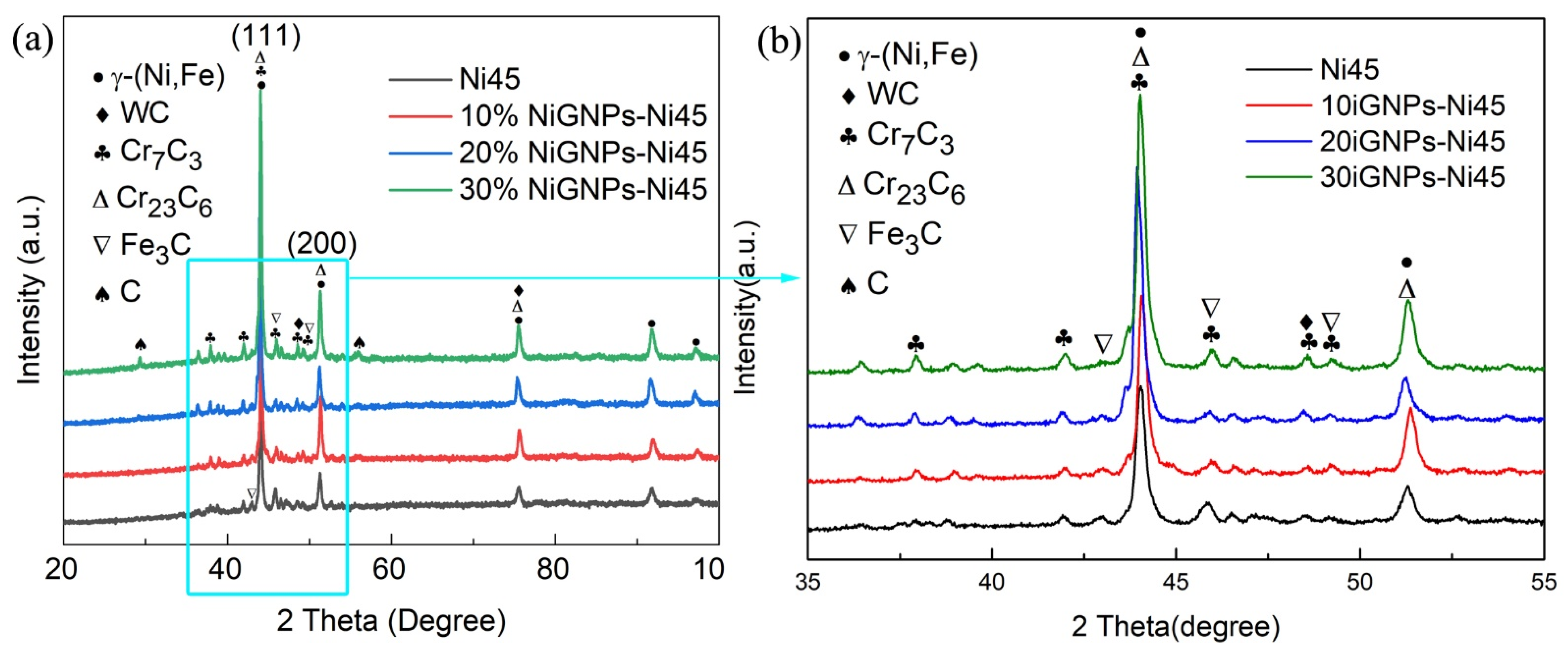

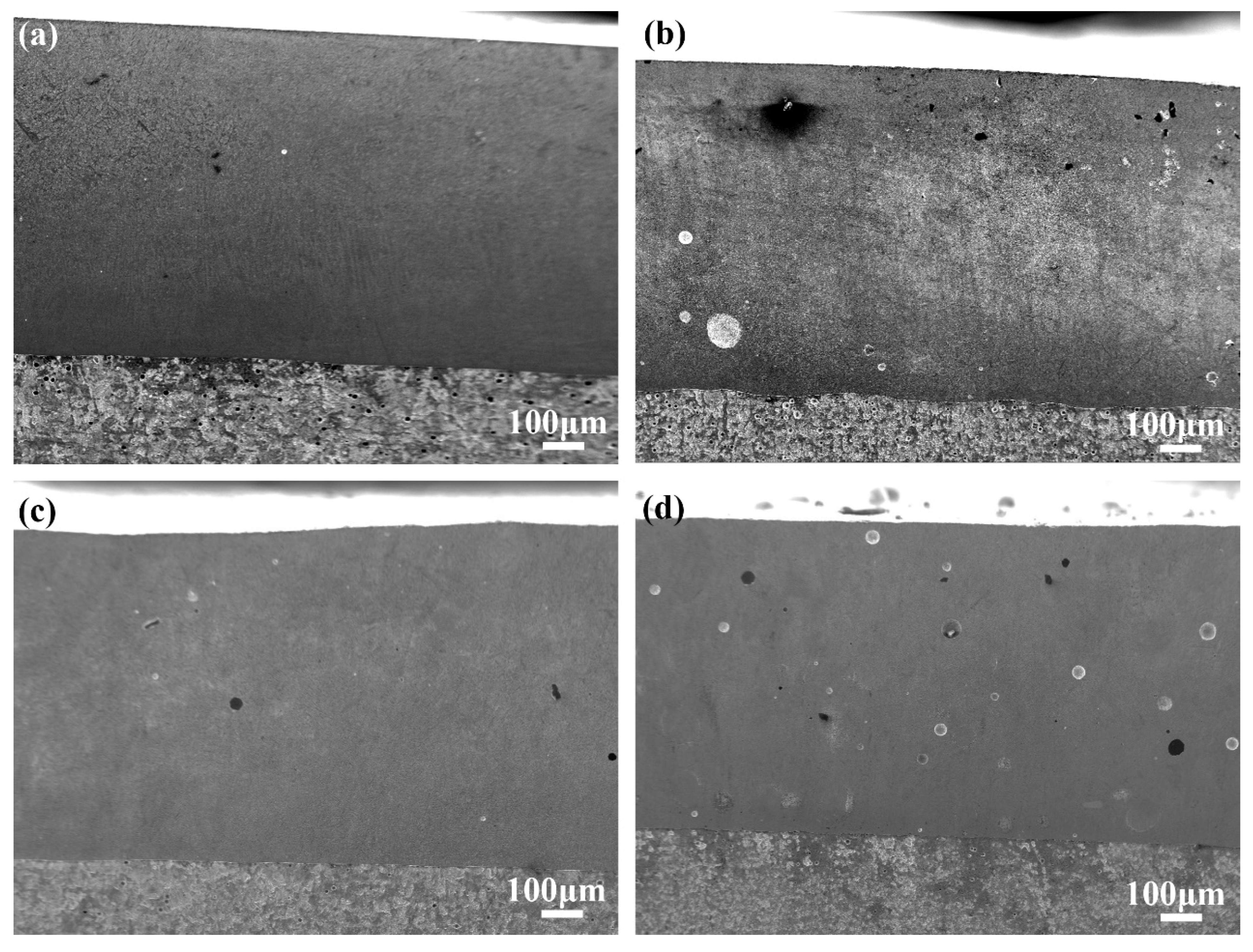
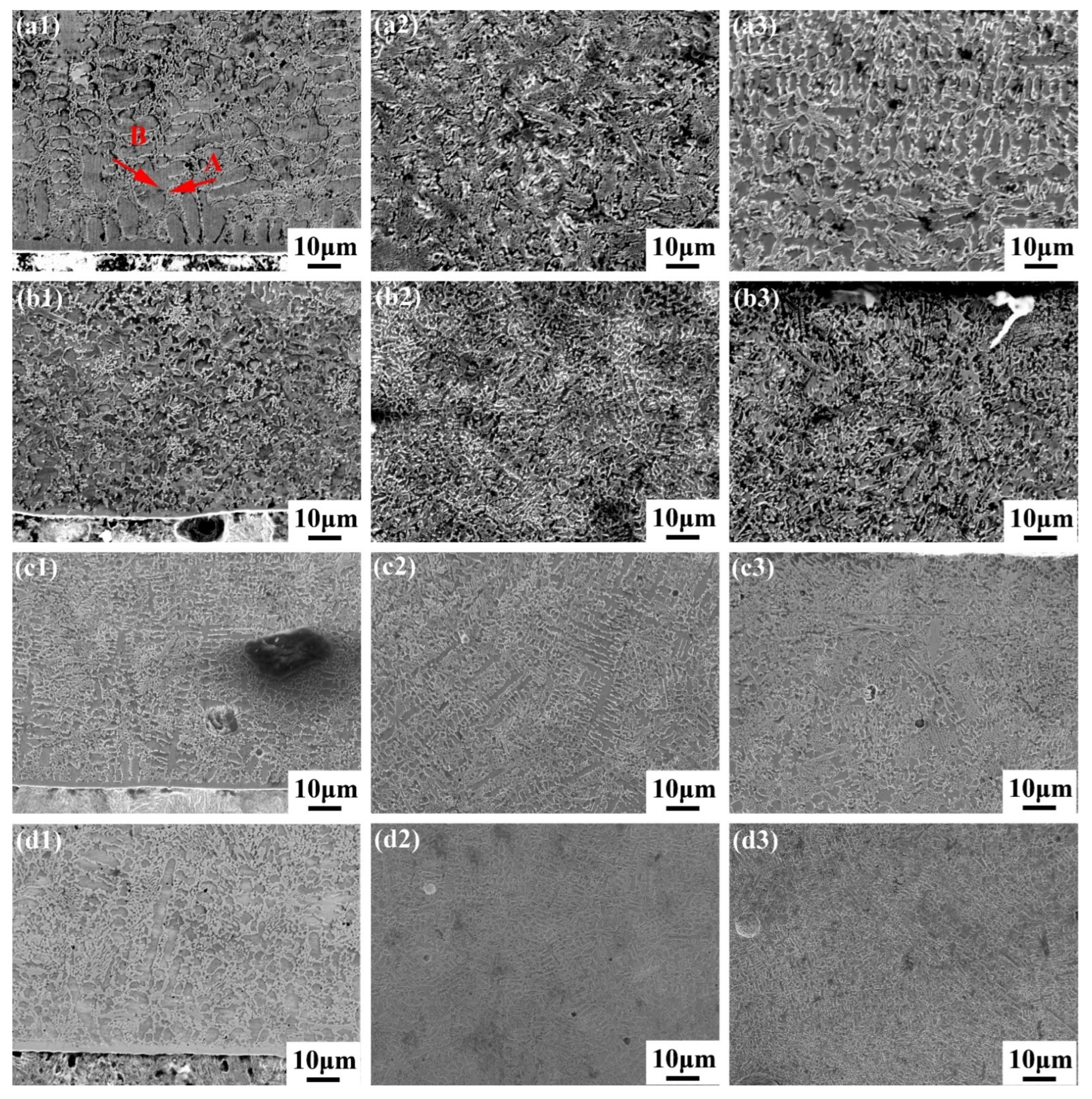
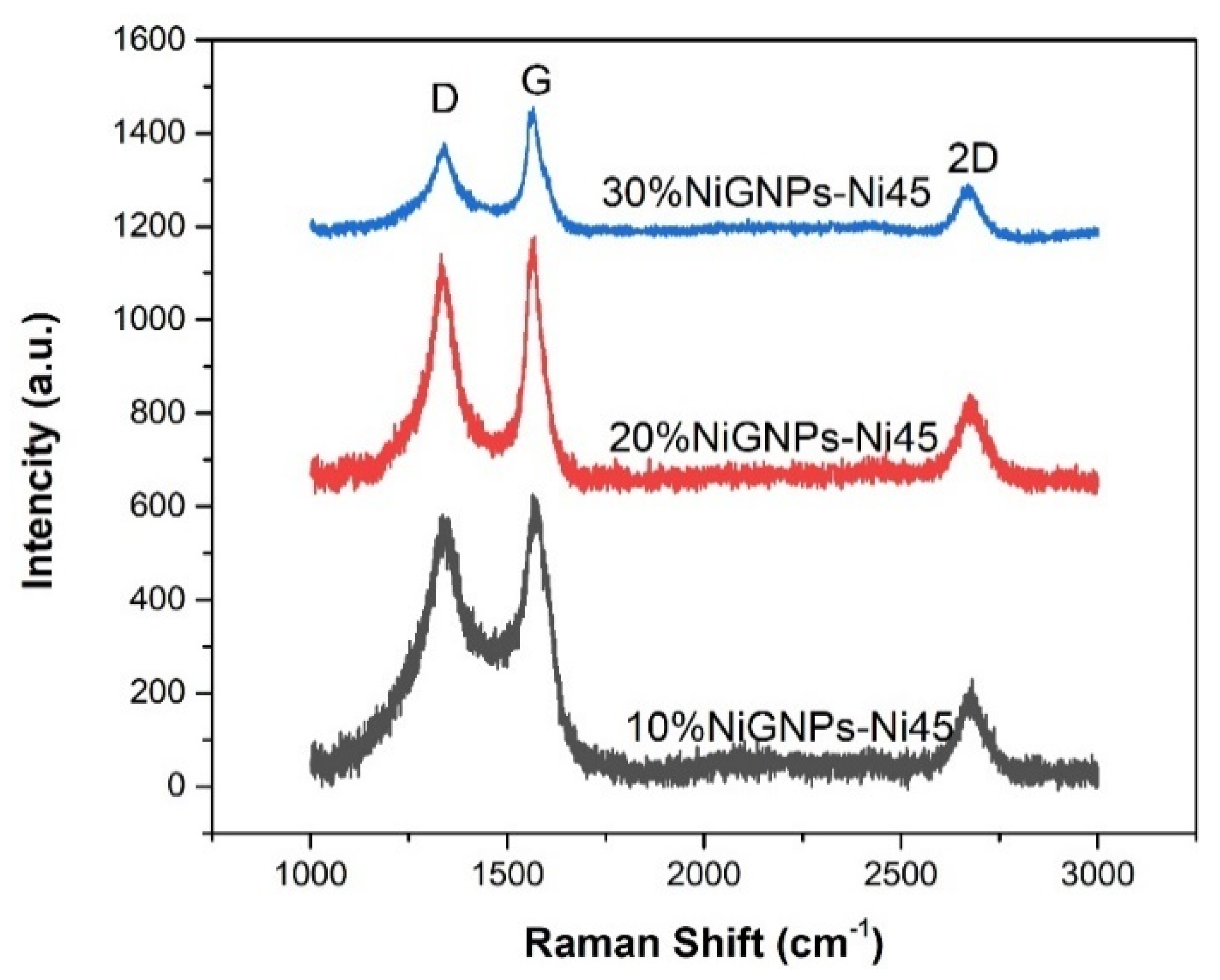

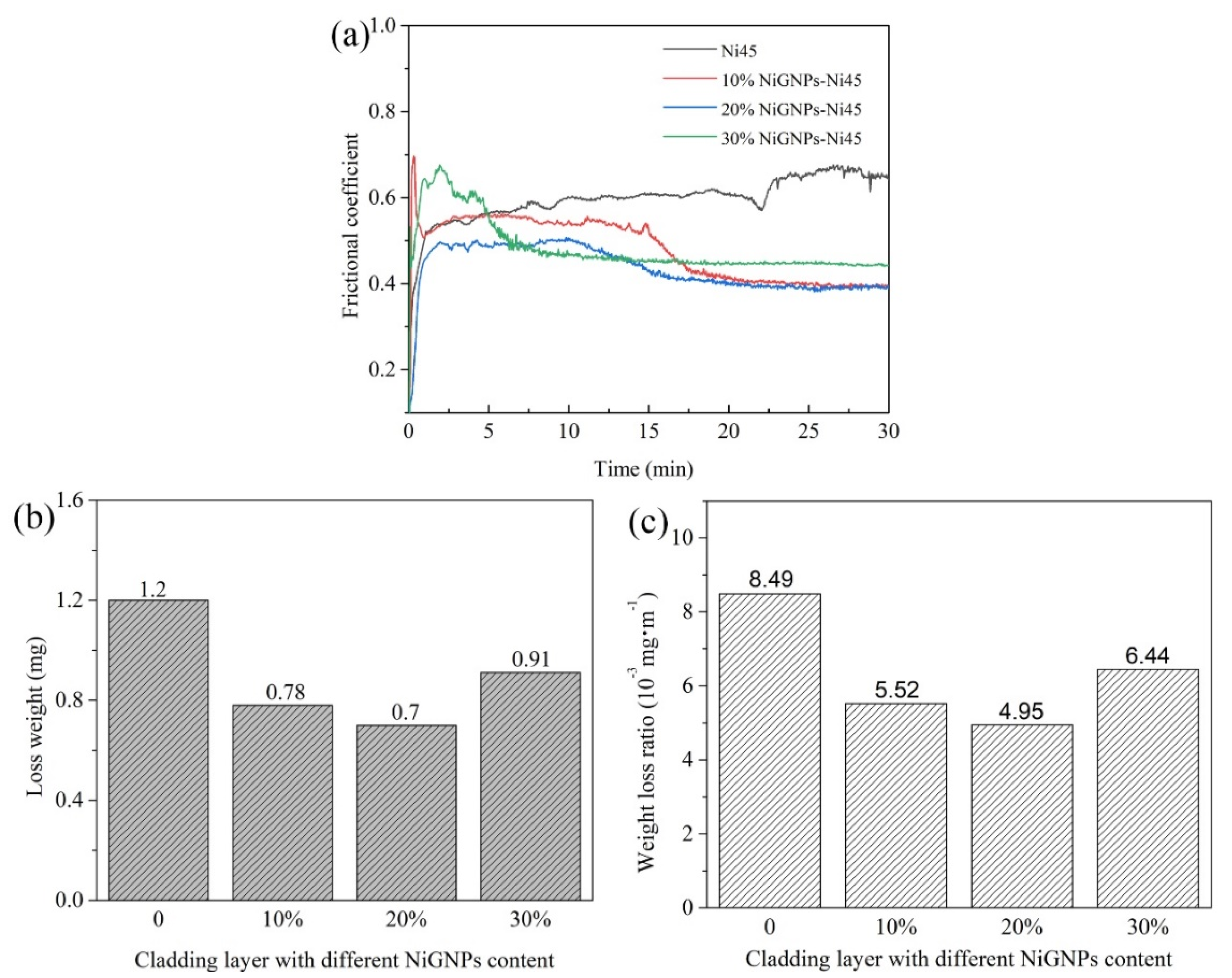
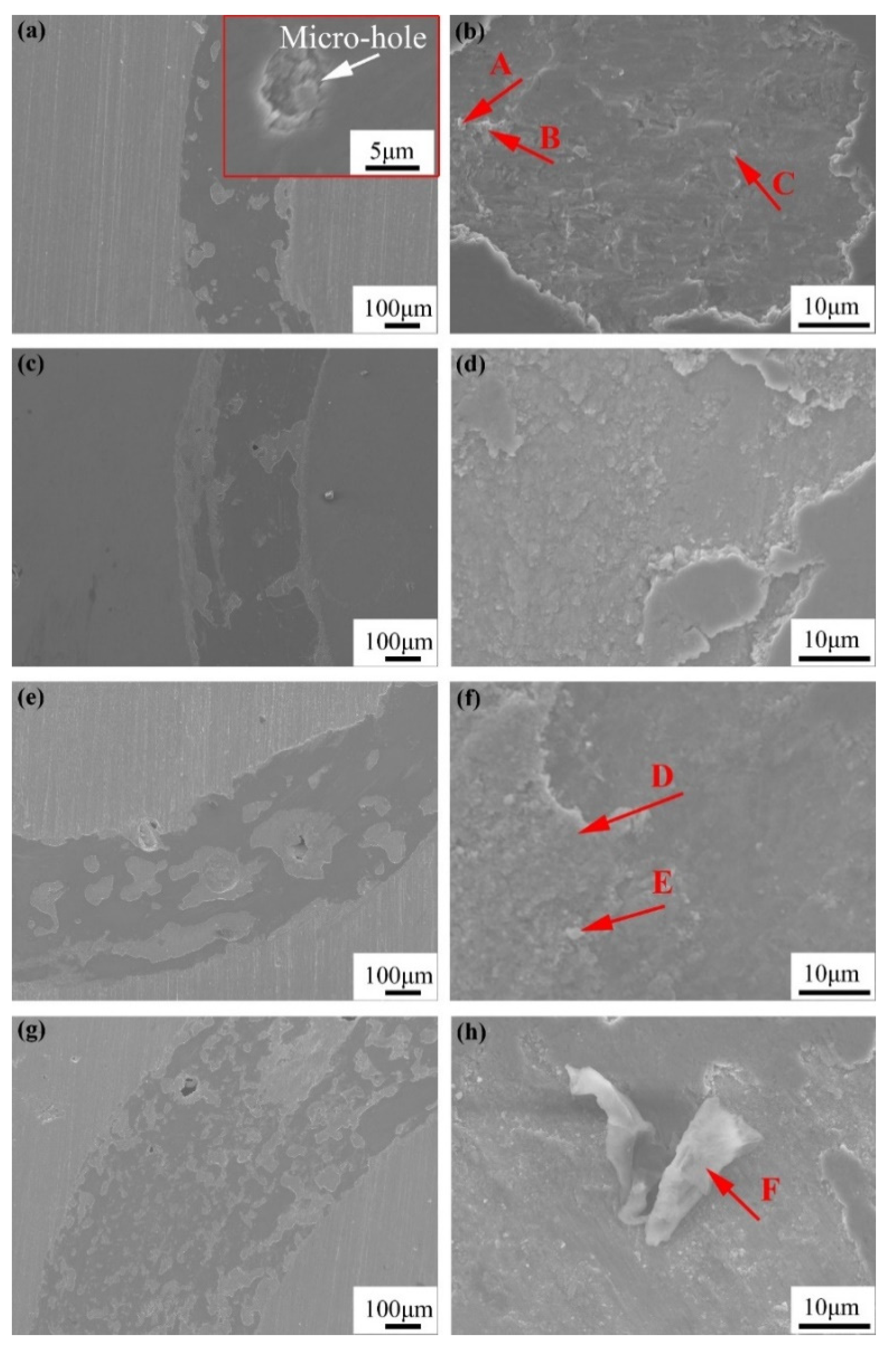
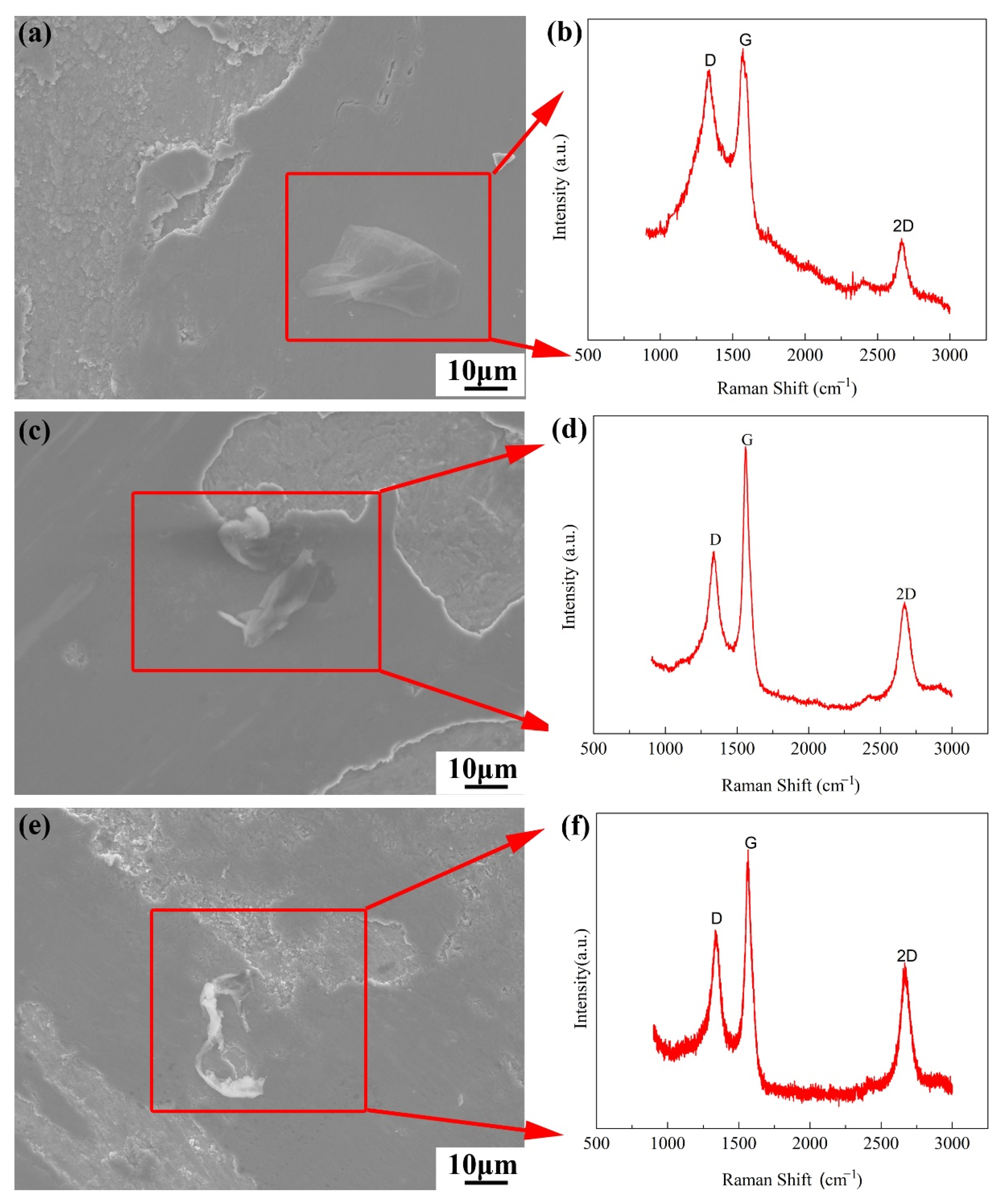
| Elements | C | Mn | Si | S | P | Fe |
|---|---|---|---|---|---|---|
| Contents | ≤0.22 | 0.3~0.65 | ≤0.35 | ≤0.05 | ≤0.045 | Bal. |
| Elements | C | Cr | Mn | Si | B | WC | Fe | Ni |
|---|---|---|---|---|---|---|---|---|
| Contents | 0.55 | 14 | 0.13 | 2.5 | 1.9 | 20 | 14.2 | Bal. |
| Laser Power (W) | Scanning Speed (mm/min) | Powder Thickness (mm) | Overlapping Rate (%) |
|---|---|---|---|
| 3000 | 480 | 1 | 30 |
| Spot | Fe | Ni | C | Cr | W | Possible Phase |
|---|---|---|---|---|---|---|
| A | 12.8 | 9.8 | 18.7 | 53.3 | 5.4 | Cr7C3 |
| B | 12.3 | 9.0 | 15.9 | 56.6 | 6.2 | Cr23C6 |
| C | 16.9 | 9.5 | 14.8 | 54.3 | 4.5 | Cr23C6 |
| D | 21.2 | 53.5 | 18.3 | 6.1 | 0.8 | γ-(Ni, Fe) |
| E | 19.6 | 18.6 | 26.0 | 32.0 | 3.8 | Cr-Fe-Ni-C |
| Spot | Fe | Ni | C | Cr | W |
|---|---|---|---|---|---|
| A | 49.6 | 10.7 | 33.0 | 5.5 | 0.7 |
| B | 49.8 | 4.9 | 42.4 | 2.3 | 0.4 |
| C | 36.0 | 29.3 | 22.2 | 11.2 | 1.3 |
| D | 72.1 | 2.6 | 23.2 | 1.5 | 0.6 |
| E | 67.6 | 2.3 | 28.3 | 1.6 | 0.5 |
| F | 22.0 | 0.8 | 76.5 | 0.5 | 0.1 |
Publisher’s Note: MDPI stays neutral with regard to jurisdictional claims in published maps and institutional affiliations. |
© 2022 by the authors. Licensee MDPI, Basel, Switzerland. This article is an open access article distributed under the terms and conditions of the Creative Commons Attribution (CC BY) license (https://creativecommons.org/licenses/by/4.0/).
Share and Cite
Han, B.; Li, G.; Chen, Z.; Zhang, G. Microstructure and Wear Property of Graphene Nanoplatelets Reinforced Nickel-Based Composite Coating by Laser Cladding. Metals 2022, 12, 1247. https://doi.org/10.3390/met12081247
Han B, Li G, Chen Z, Zhang G. Microstructure and Wear Property of Graphene Nanoplatelets Reinforced Nickel-Based Composite Coating by Laser Cladding. Metals. 2022; 12(8):1247. https://doi.org/10.3390/met12081247
Chicago/Turabian StyleHan, Bin, Ge Li, Zubin Chen, and Guoguang Zhang. 2022. "Microstructure and Wear Property of Graphene Nanoplatelets Reinforced Nickel-Based Composite Coating by Laser Cladding" Metals 12, no. 8: 1247. https://doi.org/10.3390/met12081247






